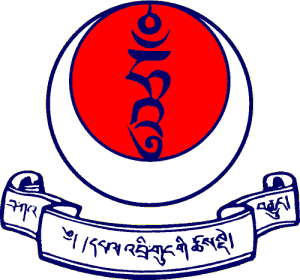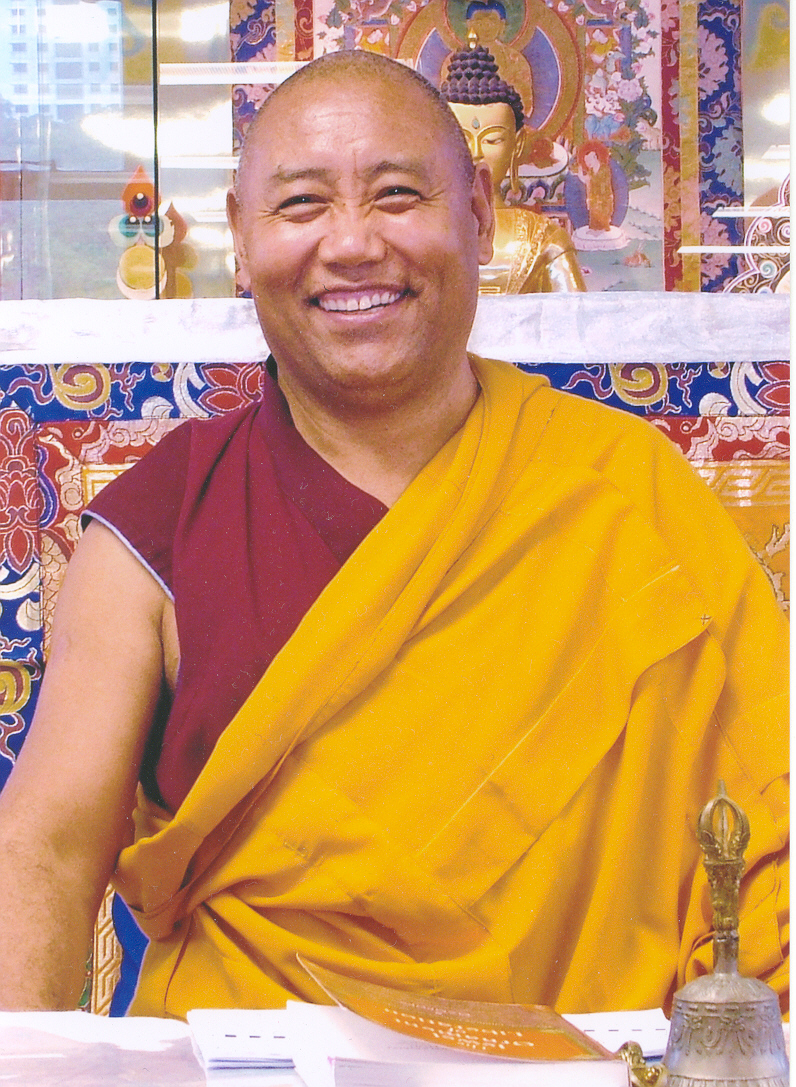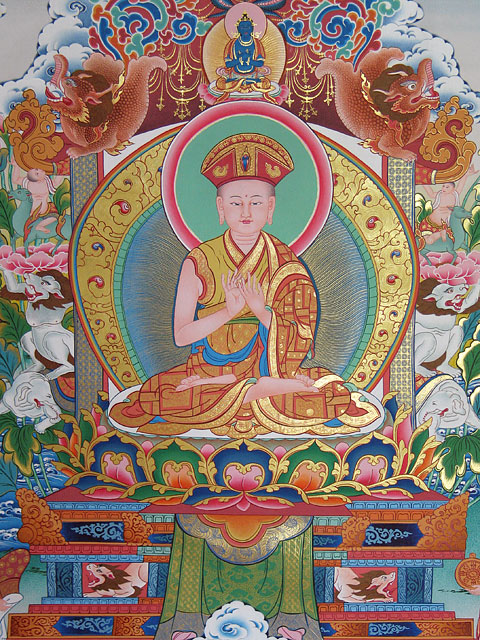| HOME |
 |
Most Venerable Khenchen Konchog Gyaltshen Rinpoche
Public Talk and Vajra Songs of Lord Jigten Sumgön
January 16 - 18, Stockholm, Sweden
 |
 |
TOP
Teaching Schedule
Rinpoche will teach directly in English.
Public Talk
January 16 (Friday), kl. 18.30 - 20.00, The Art of Living and Dying
Place: Folkuniversitetet, Kungstensgatan 45, Stockholm, T- Rådmansgatan
(near Observatorielunden, between Drottninggatan and Holländargatan)
Suggested donation: 100 kr.
Weekend course on Vajra Songs of Lord Jigten Sumgön
January 17 (Saturday), kl. 09.30 - 17.00, Vajra Song called "Tsa-uk Dzong Drum" and Short Guru Yoga
January 18 (Sunday), kl. 09.30 - 17.00, Song of the Six Confidences and How to Live in Happiness
The songs are taken from the book Opening the Treasure of the Profound written by Rinpoche himself.
The book can be purchased at the center or at the time of teaching or in any other book stores.
Venue: Folkuniversitetet, Kungstensgatan 45, Stockholm (T-Rådmansgatan)
(near Observatorielunden, between Drottninggatan and Holländarg.)
Pre-registration is not required.
Fee: 300 kr. per day (or 600 kr. for both public talk and weekend course).
No lunch will be served.
A vajra song, also called a "doha", is a lyrical Dharma teaching that is imparted spontaneously from the wisdom mind of a great master. They arise whenever needed to confer concise and precise teaching to a disciple. The term "vajra" means unchangeable, unpierceable, impenetrable, incombustible, and indestructible. Vajra songs, which were taught from the point of view of the dharmakaya or enlightenment have the same profound characteristics. Thus, it can be difficult for the unenlightened mind to penetrate their meaning. Whether short or long, each vajra song encompasses a complete form of the Buddha's teachings. We need strong devotion as well as mental clarity to comprehend their full depth.
In Tibet, vajra songs became popular when Milarepa achieved enlightenment and started giving teachings in that style to his disciples when they requested teachings. This tradition has influenced all Buddhist schools, particularly the Kagyu lineages. Monks, nuns, and ordinary people commonly memorized such songs and sang them with beautiful melodies to remind themselves of their Dharma practice and cultivate devotion for the lineage masters so that they could follow the path to freedom from suffering and confusion.
These vajra songs reflect the enlightened mind of Lord Jigten Sumgön. By merely hearing his name or reading his life story and vajra songs, many throughout the world have been moved and inspired. His experience of Dharma was not merely intellectual; he personally experienced enlightenment and revealed the meaning of nonduality. With impartial compassion based on that wisdom, he taught the Dharma sincerely to help others. His teachings comprise a method to explore our inner mental qualities by avoiding the delusions and afflictions that are the direct cause of suffering. When, with the eye of wisdom, you see the mind that cannot be seen, ultimate peace and happiness will be achieved. It is not easy to experience this meaning by relying on intellect.
Source: Opening the Treasure of the Profound by Khenchen Konchog Gyaltshen Rinpoche
Short Biography of Lord Jigten Sumgön (1143-1217)
The Drikung Kagyu Lineage was founded
by the great spiritual master Kyoba Jigten Sumgon (Sanskrit;
Ratna Shri). Lord Jigten Sumgön's father was Naljorpa Dorje, an
emanation of Bhagavan Bhera and a descendent of the Drugyäl
Kyura clan, who understood well the Abhidharma, the paramitas,
and the tantra of the secret mantra, and who was a yogin of
Vajrabhairava. His mother's name was Rakshisa Tsünma; she was a
hidden yogini. When Lord Jigten Sumgön was conceived, he entered
his mother's womb in the form of a white text that had the
nature of Vajrapani. He remained in the womb for nine months and
fourteen days, and was born in the Water Pig year (1143). His
uncle gave him the name Welwa Thar.
This beautiful child, established in
limitless virtues, far surpassed ordinary beings. For instance,
he was already accomplished in reading by the age of four. (He
would later bring with him to Drigung his style of reading,
called thel-lok, in which all the syllables are pronounced.)
Once, as a boy, he read the Manjushri Namasanghiti and when
evening came his father asked him to recite it. To the great
surprise of his family, he repeated almost all of it from
memory.
Jigten Sumgön studied all the
teachings held by his father, and at the age of nine he began to
instruct others. His uncle, Darma, taught him the Three Aspects
of Vajrakilaya. From Lhopa Dorje Nyingpo and his disciples, he
learned about Guhyasamaja. He also received teachings on this
same yidam according to the tradition of Gö Lotsawa. Under
Jetsun Khorwa Lungkyer he studied Mahamudra, practiced, and
became accomplished in the Samadhi of Illusion. He saw the
Arakta Padma buddhafield. From Lopön Kyebupa and Radreng Gomchen
he learned the stages of the teaching, the stages of the path,
and received many instructions of the Kadam tradition.
When he was fifteen, there was a
famine in the land and Jigten Sumgön's father passed away. His
mother and teachers died the next year. He then moved south and
supported himself, and his host, by reading scriptures.
Eventually he encountered Lord Phagmodrupa from whom he received
the complete lineage teachings. To integrate these within his
mind, he practiced in the Echung Cave day and night for seven
years until he attained Buddhahood at the age of thirty-five.
Lord Jigten Sumgön often said, "I practiced meditation for seven
years. For five years, I didn't know how to practice, and for
two years I practiced with full understanding achieving much
realization. So, if you practice for some years, through the
power of taming your mind you can go either to a pure
buddhafield or to a higher realm. All things depend on cause and
effect. Ultimately, all causes and effects appear from
emptiness."
When he left the cave and at the
request of humans and non-humans, Jigten Sumgon established a
monastery at Drikung Thil in 1179, thus becoming the founder of
the Drikung Kagyu order. At Drigung Thil Lord Jigten Sumgön
built a residence, an assembly hall, a temple dedicated to the
protectors that was filled with images of silver, and many other
buildings. Because of his fame and many disciples, in the Earth
Pig year of the third cycle he founded the seat of the Drigung
Kagyu order and, in that year alone, more than a hundred monks
gathered there. Later, to the memory of the glorious Phagmo
Drupa, he built an auspicious stupa of many doors with seven
different precious materials. At that time, 4,000 bhikshus were
gathered at Drigung. When Lord Jigten Sumgön was thirty-nine,
Drigung had 7,000 bhikshus divided into thirteen groups. By the
time he was forty-nine, the victory banner of practice was
planted firmly in the pinnacle of samsara in Tibet.
Many other Drigung Kagyu monasteries
were built during Lord Jigten Sumgön's life. In the Land of
Snows it was said that no other tradition flourished as did the
Drigung Kagyu. Künkhyen Pema Karpo wrote, "Thus, when the
Drigung Kagyu were flourishing, everything came under their
authority." Jamgon Kongtrul Yontan Gyatso wrote, "It was common
to say, 'The mountains are filled with Drigung hermits. The
plains are filled with Drigung patrons.'" Thus Lord Jigten
Sumgön, who was declared to be the Second Nagarjuna, performed
limitless activities that filled the whole of space and the
assembly of his disciples gathered like the disciples of Buddha
Maitreya.
Lord Jigten Sumgon wrote many
commentaries and explanations, especially the four volumes known
as Inner Profound Teachings, in which he gives meditation
instruction and advice. One of his foremost works, the Gong
Chik, contains all the essential aspects of Vinaya discipline,
Bodhicitta, and Tantra and many commentaries have been written
on this text.
When he was seventy-five, Lord Jigten
Sumgön began to think that he should dissolve the manifestation
of his vajra body. He said, "Now there are no beings I have not
helped; there are no teachings I have not given; and there are
no activities I have not accomplished. Therefore, I am happy. My
responsibilities are over. You all should work hard." To the
four khenpos and lopöns and the meditation instructor Dorje
Sengge, he gave the precious seat, along with limitless
teachings of absolute meaning. The sky filled with rainbows and
many other signs of his miracle power. According to his wish, he
passed away into the ultimate state of peace and accomplishment
at dusk, on the 25th day of the fourth month, the month of
enlightenment, in the Female Fire Ox year (1217).
(Source:
http://www.drikungboston.org/lineage.html)
More on Lord Jigten Sumgön's Biography
TOP
Most Venerable Khenchen Konchog Gyaltshen Rinpoche's Biography
The village of Tsari and the area surrounding areas are among the most sacred places in Tibet. It was there that Khenchen Gyaltshen Rinpoche was born in the spring of 1946, and it was there that he spent his early years.
In 1959, because of the political situation in Tibet, Khenchen Rinpoche fled to India with his family. The family then settled in Darjeeling, where Rinpoche began his education. Even at a young age, he was an excellent and dedicated student, and he was able to complete his middle school studies in less than the average time.
At about this same time a new university, the Central Institute of Higher Tibetan Studies, opened in Varanasi, India. Determined to be among its first students, Khenchen Rinpoche traveled to Varanasi in October 1967 to seek admission. He then began a nine-year course of study that included Madhyamika, Abhidharma, Vinaya, the Abbisamayalankara, and the Uttaratantra, as well as history, logic, and Tibetan grammar. In early 1987, he had the good fortune to take full monastic ordination from the great Kalu Rinpoche, and, shortly after graduating from the Institute, he received teachings from the Sixteenth Gyalwa Karmapa on the realization songs of the Indian mahasiddhas.
Even after completing this long and arduous course of study, Khenchen Rinpoche wanted only to deepen his knowledge and practice of the Dharma. With the same intensity that he brought to his earlier studies, Rinpoche sought out and received teachings and instructions from great Buddhist masters. One was the Venerable Khunu Lama Rinpoche, with whom Khenchen Rinpoche studied two works of Gampopa: The Jewel Ornament of Liberation and The Precious Garland of the Excellent Path. Rinpoche’s studies with the Venerable Khunu Lama also included mahamudra and many of the songs of Milarepa.
In all his studies, The Jewel Ornament of Liberation is one of the texts that Khenchen found to be most inspiring. Lord Gampopa lays out the teachings in a clear and systematic way that is understandable to beginners. At the same time, the work is such profound depth that scholars and practitioners can study it over and over and still not fully grasp its meaning. He has said on several occasions, "Anyone who knows the Jewel Ornament well can say that they really understand Buddhism."
Maintaining a balance between theoretical understanding and the practice of meditation, Khenchen Rinpoche began the traditional three-year retreat in 1978 under the guidance of the enlightened master Khyunga Rinpoche. During this time, he was able to deepen and enhance his understanding of The Fivefold Path of Mahamudra, the Six Yoga of Naropa and the profound Gong Chik text of Lord Jigten sumgon. He also received many other transmissions.
In 1985, Khenchen Rinpoche traveled to the main seat of the Drikung Kagyu lineage, Drikung Thil, in Tibet. There he was able to receive personal blessings, as well as instructions and transmissions of mahamudra and the Six Yogas of Naropa, from the enlightened master, the Venerable Pachung Rinpoche.
In 1982, the force of karma and the requests of many practitioners combined to bring Khenchen Rinpoche to the United States. By late 1983, the Tibetan Meditation Center was well established in Washington, DC. Their original location was the site of innumerable teachings, practices, retreats and ceremonies. In September 1984, and again in 1987, the young Center was blessed with personal visits and teachings by His Holiness the Dalai Lama. Through Khenchen Rinpoche's and the Center's efforts, Drikung Kyabgon Chetsang Rinpoche visited later in 1987, and people in several states were able to receive benefit from his teachings and presence.
Wanting the teachings of Dharma to reach as many people as possible, Khenchen Rinpoche has quickly adapted himself to Western forms of communication. He has made appearances on television, been a guest on many radio programs, lectured extensively at colleges and universities, and spoken to the public through countless newspaper articles.
Rinpoche’s compassion and dedication to the Dharma have taken him to all parts of the world. Rinpoche travels tirelessly, giving teachings, leading retreats and opening Dharma centers throughout North America, South America and Europe. He has established centers throughout the US and in Chile, and he frequently visits in Europe, countries like Germany, Italy, Austria and Sweden, as well as Southeast Asia. Between 1983 and 1990, Khenchen Rinpoche single-handedly translated critical Drikung Kagyu meditation practices, prayers and histories into English. The originals of the texts were all written out by his hand: Achi Chokyi Drolma, Amitabha, Bodhicitta, Chakrasamvara, Chod, the complete Ngondro, Five-fold Mahamudra, Four-Session Guru Yoga, Green Tara, Lama Chopa and tsok, Mahakala, Mandala offering, Manjushri, Medicine Buddha, Milarepa Guru Yoga, Nyung Ne, Peaceful Guru Padmasambhava, Phowa, Refuge, Chenrezig, Vajrapani, Vajrasattva, Vajrayogini, and White Tara. The Illusory Body teachings, Supplication to Tara, Treasury of Benefit and Happiness, Meaningful to Behold, many other prayers and three of his four books were all translated and published during this time. This priceless work formed the essential base from which the holy Dharma could be taught and practiced. Because of his efforts, Western students are now able to read and perform these practices in their own language.
In November 1991, Khenchen Rinpoche and the Tibetan Meditation Center moved to Frederick, Maryland. Nestled inside a state park, the Center is now situated on four wooded acres. A small temple has been built there, and was consecrated by His Holiness Chetsang Rinpoche in 1994. With this larger facility and in surroundings more conducive to contemplation, Rinpoche has been able to benefit even more people with his teachings. Now that Western students are becoming interested in long term retreat practice, plans are being made to establish a residential retreat center nearby.
A skilled and dedicated translator, Rinpoche has published seven books before this: Prayer Flags, In Search of the Stainless Ambrosia, The Garland of Mahamudra Practices, The Great Kagyu Masters, The Jewel Ornament of Liberation, The Jewel Treasury of Advice and The Transformation of Suffering. In this way, Rinpoche has been able to make important texts available to the public and to provide his students with a thorough and systematic training in the Dharma. Rinpoche has taken enormous care to make each translations as precise as possible. Because he himself has been so moved by these words that come directly from great masters, he believes it is critical that these same words be presented in an unadulterated manner. For example, to translate this text, he and his editor went through the entire text word by word four times, sometimes spending an hour or more on a single phrase or sentence. It is his sincere hope that, through this genuine effort, the readers will be inspired like himself by these precious Dharma teachings.
As a public figure, Khenchen Rinpoche continues to write, to translate texts, and to teach whenever requested. He has traveled to the Drikung Kagyu Institute in India, where he taught the Gong Chik to a group of about ninety monks and nuns. With the financial assistance of friends and students worldwide, Rinpoche was able to print 1,700 copies of the gong Chik and to distribute them to the students of the Institute, as well as monks, nuns and monasteries in India, Nepal and Tibet. In 1996, Rinpoche printed and distributed 1,500 copies of Essence of the Mahayana Teachings by Ngorje Repa, an important disciple of Lord Jigten Sumgon.
Remembering the struggles of his early years, Khenchen Rinpoche inspires and supports monks, nuns and the laypeople in their practice of the Dharma and is always ready to assist them in whatever way he can. To turn the Dharma wheel, Khenchen sacrifices all his comfort. He has recently spent several months traveling to various places in Tibet bestowing tiredlessly the precious Dharma teachings to local monks and nuns. To all, he gives of himself freely. With his heart and mind turned firmly towards the Dharma, he compassionately and with great patience shows the way.
We are gratified to hear that His Holiness Drikung Kyabgon Chetsang Rinpoche will enthrone Khenpo Konchog Gyaltshen Rinpoche as a Khenchen (Great Abbot) by on January 16, 2001 at Jangchub Ling monastery, Dehra Dun, India. This is indeed a very great honor and great inspiration to all of us. We are all inspired by his unceasing altruistic effort in teaching the Dharma, in guiding us onto the Path so that we recognize Dharma as our ultimate friend.
In more recent years, Khenchen Rinpoche spends a great deal of his time traveling in order to give teachings and lead retreats. He has established centers throughout the US and in Chile, and he frequently visits in Europe, especially Germany and Austria, as well as Southeast Asia. A skilled and dedicated translator, he has published numerous books: Great Kagyu Masters, Garland of Mahamudra Practices, Jewel Treasury of Advice, Prayer Flags, Jewel Ornament of Liberation, Transformation of Suffering, Pearl Rosery (The Path of Purification), Calling to the Lama from Afar, A Complete Guide to the Buddhist Path and Opening the Treasure of the Profound.
Audience with Rinpoche
Audiences will take place at
Ratnashri Meditation Center (Friggavägen 11, Lidingö) on Friday
morning January 16. Pre-registration to the center
(info@ratnashri.se) is required.
Suggested Readings
Previous
Dharma teachings by Venerable Khenchen Konchog Gyaltshen
Rinpoche
Dharma Books written by Venerable Khenchen Konchog Gyaltshen Rinpoche
